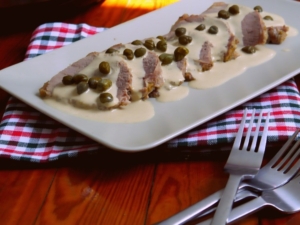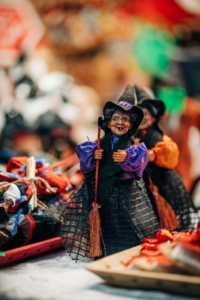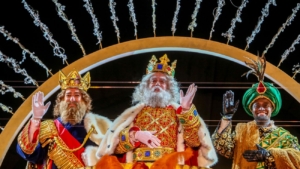AROUND THE WORLD CHRISTMAS TRADITIONS
Get on the polar express! It’s December and on the blog we are still on board the Christmas train. Have you ever wondered how these dates are celebrated in other places around the world? We spend the season in an overexposure of images corresponding to the Netflix Christmas movie repeated endlessly: Santa Claus, decorated pine tree, shopping, hot cocoa, snow, dinners and gifts. Although that holiday template is canonical and touching, it can’t be all! Our world is rich in cultures and traditions.
I want to share with you other different and interesting ways to celebrate this season where some of my international friends grew up.
ARGENTINA
My friends Flavia and Adelina reminded me that in Argentina it is summer during Christmas. Something that my head just can’t imagine! Christmas on the beach or swimming in a pool with a cold drink is common during these times. The roast cannot be missed, with a suckling pig or a goat, a meal that takes at least six hours on the grill! Or the vitel toné, also typical, a dish that is served cold with slices of very tender meat and a sauce with tuna and mayonnaise. Gifts are opened at midnight, during or after fireworks, not the next morning, like in other countries. An interesting tradition is to buy or give pink underwear at Christmas to wear for the New Year. It is something that aunts or the oldest women in the family give to the youngest ones, as a representation of the emotional side, and the attraction of everything positive, of sweet love, and fertility.

Vitel Toné. Source: Paulina Cocina, 2015.
AUSTRALIA
Australia is quite multicultural, so the traditions tend to vary a bit family to family. My friend Ben considers that commonly Santa comes overnight, and the children will open their presents first thing in the morning. The big meal of the day with extended family is usually lunch, where the entre is usually cocktail prawns, the main will sometimes be roast meats, but also cold meat platters and salads because it can be as warm as 40 degrees on Christmas day. A common dessert is pavlova with fruit (delicious Australian/New Zealand food invention). On these celebrations, many Australians wear paper crowns as Christmas hats and drink lots of beer! On the 26th, there’s always the first day of a test cricket match. It wouldn’t be uncommon for a mix of family and friends to get together and watch that as part of a lazy day afterwards.

Christmas crown. Source: Free Images Live, 2023.
CHILE
According to my friend Cata, in Chile they eat the traditional pan de pascua, a dessert with dried fruits similar to Stollen, and drink cola de mono, a cold drink prepared with alcohol, coffee and condensed milk with sugar. Their Christmas is called Pascua, their Santa Claus is “El Viejito Pascuero”, and many children believe in him. However, something that is a bit difficult for them to understand is why the Old Man comes dressed so warm when it is summer here and it is so hot? The explanation is that he did not have time to change his clothes, the same ones he wears in his home at the North Pole.

Pan de pascua and cola de mono. Source, Lorenzo Gatica, 2020.
CHINA
I have several Chinese friends, who have chosen names in Spanish: Noa and Celeste told me that there are no official holidays in China during this time, since it is not a traditional celebration. But with the introduction of foreign cultures, in large Chinese cities, such as Shanghai, there is a strong Christmas atmosphere. More than a party for believers, it is a party for consumers and for the curious. There will be Christmas decorations everywhere, in shopping centers or in street stores. Young people usually go out with their friends after work or school to celebrate Christmas. However, in some places, like public areas or schools, there is often resistance to Christian Christmas symbols. Something very curious is that in China, Christmas Eve is called “ping an ye”, which in Chinese is pronounced like apple. Because of this, people have taken up the tradition of giving apples to each other, to their loved ones, friends or family.

Christmas apples. Source: Javiertzo, 2018.
COLOMBIA
Two of my closest friends, Angy and Liz, are Colombian. In their country, they celebrate the “Día de las velitas” (Day of the candles) on December 7th, a tribute to the Virgin Mary. After sunset the candles are lit, and for each lit candle you can make a wish or an intention: for family, health, prosperity… the next day you usually go to church. On the 24th they usually have turkey for dinner or some typical dish, such as ajiaco (dish prepared with chicken, potatoes, and different vegetables) and on the 25th they take the “Paseo de olla” (Pot walk), where people go with their pots and their family to the river bank to prepare some special soup or sancocho with firewood. Common to Latin cultures, there is a lot of eating and dancing. Another peculiarity of the season in Colombia is that nine days before Christmas, the “Novena de Aguinaldos” is held, a series of prayers and songs to prepare for the arrival of baby Jesus, a tradition that dates back to the 18th century. This is done together with neighbors and family, and at the end of each day’s prayers a meal is shared with everyone who participated.

Día de las velitas. Source: El Informador, 2019.
ITALY
In many parts of Italy, including Venice, where my friend Isabella grew up, Christmas Eve is spent with the family. They normally eat lean fish. Once dinner is over, they usually go to midnight mass together. As for Christmas Day, gifts are exchanged and traditional dishes such as tortellini in broth and stuffed cappone are generally eaten. Panettone is a must, such as pandoro with mascarpone sauce, nougat, nuts and dates. Italy has a special character delivering children their gifts on the night of January 5th: the Befana. She is a kind of witch, an old woman who flies through the sky on her broom. In some places, however, a bonfire is held on the night of January 5th, where the befana burns, thus expelling the old year.

La befana. Source: Gabriella Marino, 2022.
CUBA
My friends Aracelis and Rogelio are Cubans and they told me that in 1959 the revolutionary government tried to get rid of Catholic Christmas because they considered it opposed to communist principles. So people began to celebrate humbly, only with the close family. That night, traditional food is served: pork, congrís rice, cassava, and salad. Only after Pope John Paul II’s visit in 1998 (the first visit by a Pope to Cuba) did the government declare December 25th a holiday. Furthermore, in the city of Remedios “Las Parrandas” are celebrated on the night of the 24th, which are very colorful and competitive popular festivals, declared National Heritage. Monuments are replicated, floats are decorated, choreographies are prepared, and all the inhabitants of the interested communities participate in the preparations.
Another interesting tradition is the creation and burning of the rag doll: „la quema del muñeco de trapo„. In Havana, a doll that represents the old year is created among the neighbors and burned at midnight on December 31st as a way to end that year. Also at midnight, buckets of water are thrown into the street and a suitcase is taken out onto the street to approximate the time of travel.

Quema del muñeco. Source: Directorio Cubano, 2022.
ROMANIA
My friend Eliza told me that Christmas in Bucharest, Romania is a vibrant and traditional celebration that blends religious observances with enchanting customs. The spirit of Christmas starts early, with the arrival of St. Nicholas (Moş Nicolae) on December 6th. He enters homes through chimneys and leaves presents for the children in their shoes or stockings. Another significant part of the Christmas preparations is the slaughtering of a pig (Tăierea porcului), a tradition that symbolizes abundance and generosity. The pig’s meat is used to prepare various dishes, including sausages, pâté, and roasted or stewed pork. The Romanian Christmas tree is decorated with intricate paper ornaments, gilded walnuts, dried fruits, and homemade star-shaped bread called cozonac. Christmas Eve is marked by a special feast that includes traditional dishes like sarmale (stuffed cabbage leaves), piftie (jellied meat), and sarmale cu prune (stuffed cabbage leaves with plums). The feast is preceded by a light meal of wheat grains sweetened with honey, known as coliva. Caroling (colinde) is an essential part of Romanian Christmas traditions. Young people form groups and go door-to-door, singing traditional carols and receiving gifts of food, drinks, or money in return. Moș Crăciun, the Romanian Christmas Man, arrives on Christmas Eve or Christmas Day to distribute gifts to the children. Traditional Romanian children’s poems and songs are exchanged during his visit.

Cozonac bread. Source: Cristi Ursea, 2023.
SPAIN
Many of the Christmas traditions in Latin American countries have their origin in Hispanic culture. However, there are some particularities, for example, in food. As my friend Natasha told me, a Spanish Christmas Eve dinner usually consists of tapas as a starter, then meat and finally desserts; one of the favorites is turrón, also mazapanes (marzipan). There is a tradition for young people called “maitines”: parties until dawn with friends in an enclosure. On the morning of the 25th, gifts are opened.
To welcome the New Year, the tradition is to eat 12 grapes at 12 midnight following the 12 bells before the change of year. For each grape a wish is made. It is also customary to dress that day with something old, something new, something red and something borrowed, because it brings luck for the following year. The celebrations last until January 5th, the day of “La cabalgata de reyes” (The Three Kings Parade) which is a parade with several funny characters, crowned by the three wise men: Melchor (gold), Gaspar (myrrh) and Baltazar (incense). They are the ones who visit schools, bring most of the gifts and generate much more cheer than Santa Claus.

Cabalgata de Reyes. Source: TeleMadrid, 2022.
EQUATORIAL GUINEA
My friend Reyes lives in this African country and she tells me that it is very hot at this time. Having been a Spanish colony, the influence of this culture on Christmas is great. There is a curious ritual for the New Year: people usually ring in the New Year by taking a swim in the sea! It is typical to spend the first day on the beach so that the water washes away the old and only brings in the new. It is also a family culture, where either dinner on the 24th or lunch on the 25th is spent with loved ones.
MEXICO
In my country we have “Las posadas”: pre-Christmas parties with co-workers, family and friends, where the most traditional rituals include: A song that simulates the journey of Mary and Joseph to find a place to spend the night, where the participants are divided into two groups to sing: those who ask for accommodation and those who grant it. A colorful star-shaped piñata with seven peaks, representing the seven deadly sins; a stick is used to break it and, when doing so, fruit falls out as a symbol of God’s grace. A pastorela, which is a theatrical representation of the arrival of baby Jesus and the battle between the devil and the angel, who dispute the path of the shepherds. Some typical foods are tamales (corn dough wrapped in a corn or banana leaf), fruit punch, and rosca de reyes (a circle of bread where plastic figurines in the shape of a child are hidden). The person who finds a figurine in their piece must buy the tamales for February 2nd, Día de la Candelaria. As for the end of the year, red (for passion) or yellow (to attract money) underwear is also used. Coins are also often exchanged or swept inside the house to attract prosperity.

Piñata. Source: El Sol de México, 2018.
Do you know any other Christmas traditions? What is your favorite one? Share it with us in the comments.










Hola Tania gracias por el tour navideño con esto me dan ganas de viajar en navidad 🎄 a otras partes del mundo. Me gustó mucho subir al expreso polar y viajar contigo